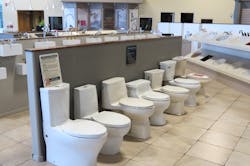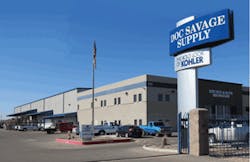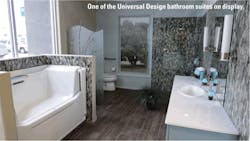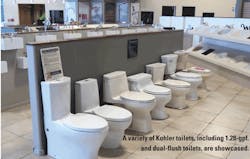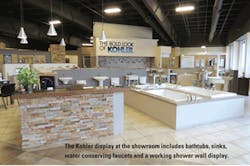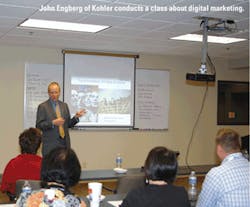Training, sustainability is essential to Doc Savage Supply
Since 1965, Doc Savage Supply, a locally owned and operated wholesale plumbing and HVAC showroom, has been providing plumbing, heating and air conditioning products for the residential and commercial markets in New Mexico. Recently, the company, located in Albuquerque, N.M., moved into a brand new 7,000-sq.ft. bath and kitchen showroom, displaying a variety of kitchen and bath fixtures, where contractors, designers, architects and homeowners can visit and see products up-close and personal.
Combined, Doc Savage Supply employees have almost 200 years of collective experience in the wholesale plumbing and HVAC industry. The company also offers employees, contractors, designers and other industry professionals factory-sponsored training in all major product lines.
Regarding customers, Ed Donahue, president and owner of Doc Savage Supply, says that approximately 70% are plumbing subcontractors and 30% are general contractors. However, architects and designers also come into the showroom, not only to see products, but to participate in training classes the company offers.
In the past few years, most customers have purchased products for residential remodeling projects, but some new projects are starting to pop up.
“We have an outside sales department for commercial jobs, but 99% of our business is residential,” says Carla Wersonick, Doc Savage Supply’s showroom manager. “The past few years it has been mostly remodel work. We are starting to see more new home building, so this is exciting.”
Where it all began
Walter “Doc” Savage opened Doc Savage Supply in Amarillo, Texas, in the 1950s, opening a location in Albuquerque, N.M., in 1965.
“Doc passed away around 1970 and his widow kept the company,” says Donahue. “I believe they had four branches, and they kept growing the business until around 1987. They then decided to sell the Albuquerque location to the then general manager, and I acquired it in 2004.”
The showroom dates back to 1998 at the old facility. In 2006 Donahue decided to find a more suitable facility, and figured it was best to build a new building and showroom from scratch. Taking only 11 months to build, the company moved into the new location the summer of 2009. The entire facility is about 50,000-sq. ft., and the showroom is 7,000-sq.ft.
A year before Doc Savage Supply broke ground Donahue interviewed three different showroom design firms and decided that Ellen Cheever was the best fit.
“Ellen Cheever was a real gem to work with, and did a great job,” said Donahue. “Ellen’s delightful personality, ability to listen, hands-on approach, and industry reputation were key factors in choosing to work with her design firm. The end result exceeded our expectations. We highly recommend Ellen and her competent staff.”
Target markets
“One of the key markets we are targeting is aging-in-place,” says Wersonick. “One of our key displays is an ADA bathroom. Just because it’s ADA doesn’t mean the bathroom has to have a sterile medicinal look. ADA can be beautiful. There are also a lot of Universal Design components that can be used for aging-in-place too.”
When you look at the market, the baby boomers are starting to age and retire, explains Wersonick.
“A lot of the people are homeowners and are asking for these products,” she adds. “They might not be aware of the terminology of what they are asking for, but they are asking for ADA items. We just started focusing on that area since all it’s going to do is grow.”
According to Donahue, a lot of the company’s ability is to focus on aging-in-place and water conservation, so moving into a new space, and designing it from scratch really lent itself well to focusing on those specific products.
"It was important to design the showroom accordingly and make things modular since things change, products get better and require change out,” said Donahue.
Sustainability is another key market especially since water conservation has been an issue in the West since the beginning of recorded time, according to Donahue.
“We have some really neat history of the Anasazi Indians,” explains Donahue. “These people were cliff dwellers, and there is a lot of theory as to how they came and disappeared. The most prevailing theory of them is that lack of water in this climate was traumatic and drove them out from where they lived, the four corners area [the southwestern corner of Colorado, northwestern corner of New Mexico, northeastern corner of Arizona and southeastern corner of Utah].
“The huge growth in the Southwest (from Los Angeles to east of Phoenix) is a huge consumer of water,” continues Donahue. “All of us depend on water. It’s always been an issue, even for the Anasazi Indians, and now it’s more important than ever. Like our friends at Kohler have taught us … with water there is an issue of scarcity, but scarcity also makes water expensive. It is the basic market conditions and climate conditions that have been around forever that really dictate conservation.”
Donahue adds that there was an interesting article, “Green Goes Mainstream for Metro Builders,” that was published in the Albuquerque Journal. The article notes that D.R. Horton, a Fort Worth-based homebuilder, active in 73 metros in 25 states, pulled 162 green permits in Albuquerque, N.M., last year, pushing the total number of green homes built in the city to 36.5% of all single-family home construction in 2011.
“In the article the nationwide stat for green homes was 17%, so that means we are slightly more than double the national average,” explains Donahue. “That underscores how important water and energy conservation is here.”
Just some of the water conserving products at the showroom are 1.28-gpf. toilets and dual-flush toilets by Kohler, Sterling and Caroma. The showroom also features showerheads that can be 2.0-GPM or 1.5-GPM. And there are a variety of water-conserving faucets to pick from.
Wersonick points out that if a product is not efficient, such as a faucet, there are a number of different things that can be done to make it efficient, such as changing the aerator.
Regarding high-efficiency toilets, Wersonick says that many consumers like the idea of a higher efficiency toilet, but some still are hesitant because of what happened when 1.6-gpf toilets came out. To remedy that concern, Wersonick says that all that needs to be done is to explain and help the consumer understand why those concerns are not legitimate anymore since products have changed. Besides showcasing high-efficiency toilets, many of the toilets displayed in the showroom are WaterSense labeled.
Just some of the toilets displayed at the showroom are Kohler’s newly redesigned Highline toilet, which is 1.28-gpf, and the Gabrielle one-piece toilet, which is also 1.28-gpf.
According to Wersonick, both toilets get rated at 1,000 grams, which is the highest you can get on the MaP Testing.
Besides offering bath and kitchen plumbing fixtures, Doc Savage Supply also showcases a high-efficiency tankless hot water system, and the company is growing the HVAC side of the business.
“Right now, HVAC is about 10% of total revenue,” says Donahue. “We do offer Energy Star equipment, but it’s really not displayed in the showroom.”
Major brand suppliers for the showroom include Kohler, Delta, Brizo, Moen, Grohe and Armstrong Air. Other brands available at Doc Savage include, but are not limited to, Grundfos, Uponor, Viega, Watts, Hansgrohe, State Water Heaters and Takagi.
Training is essential
Overall the company has 17 employees, three working in the showroom.
"All of us in the showroom are very good at visualizing what the customer, primarily contractors, wants,” says Wersonick. “We help them with their vision and if there is something that we can see that might be an issue down the road, we can help them with this.”
Wersonick is a Certified Aging-In-Place Specialist (CAPS). She received this certification in 2009 via the National Association of Home Builders. CAPs courses are a full day each, and three are required: Marketing and Communications Strategies for Aging and Accessibility (CAPS I), Design/Build Solutions for Aging and Accessibility (CAPS II) and Business Management for Building Professionals.
“Training at the showroom is geared towards a spectrum of people, mainly our contractors, to bring them up to speed in a variety of areas, whether it’s CAPS or what they need to do to be certified by the EPA for lead removal,” says Donahue. “We have a whole host of classes running from A to Z: We do HVAC training, product knowledge training, CEU classes, we had a Kohler event last October.”
If it’s a lunch-and-learn session about a specific product line, it’s helpful for the designers and contractors to be able to see the product up close, says Wersonick.
Many different building professionals attend the classes offered.
"We have contractors and some designers and architects, we have had a smattering of people in these classes,” explains Donahue.
“When we had our CAPS certification here, we have had some people involved in the medical industry attend these classes too,” says Wersonick.
The firm has about 10 people on average attend the classes, but it depends on what the class is about, notes Donahue.
“We have had as little as eight people, but we’ve also had to limit a class to 40 people,” says Donahue. “It can be very specialized or it can be like the CAPS courses, where there are more people in this class, from contractors to designers to people in the medical industry.”
For the courses offering CEU credits, such as the lunch-and-learn classes, the manufacturer usually sends a certified staff member to oversee the course. For example, last October, an all-day Kohler workshop with four separate classes was offered. The Kohler team came to the facility to teach the CEU classes.
Besides training contractors, employees of Doc Savage Supply also participate in training courses. Many employees have been trained at manufacturers’ facilities to keep them abreast of new products and technology.
“We also have in-house training for employees, such as product trainings,” explains Donahue. “We have business training in which we talk about gross margins, basic business fundamentals, etc. We offer training to all our people, especially if it’s a new product line we are taking on. We sometimes host a separate training class for our employees or they take classes with the contractors.”
“There is nothing better than being trained by the manufacturer about the product,” exclaims Wersonick.
Donahue says that thanks to the new facility, the company is better equipped to handle these types of training needs.
“Our training room is 2,000-sq.ft. and will hold 40 people comfortably,” explains Donahue. “Overall the big push into training started with the new facility. We intentionally built the training area for this capability. This is not only good for our employees, but good for our business.”
To get the word out about the courses, mass faxes and e-mails are sent out to customers and followed up with phone calls.
“The Kohler event in October was heavily promoted with formal traditional mail,” explains Donahue. “How we get the word out depends on the nature of the class or workshop. Some of the classes we hold with our local Home Builders Association in New Mexico. When we hold courses for them, they basically take care of the marketing end of it. However, since we don’t want to limit it to the home builders we also open it up to others.”
This April Doc Savage Supply is hosting the local Green Building Council Lunch and Learn with the focus on Manual J essentials (Manual J is the methodology for sizing heating and cooling equipment for a home or office).
Additional information can be found at: http://www.docsavagesupply.com/.
About the Author
Candace Roulo
Candace Roulo, senior editor of CONTRACTOR and graduate of Michigan State University’s College of Communication Arts & Sciences, has 15 years of industry experience in the media and construction industries. She covers a variety of mechanical contracting topics, from sustainable construction practices and policy issues affecting contractors to continuing education for industry professionals and the best business practices that contractors can implement to run successful businesses.
